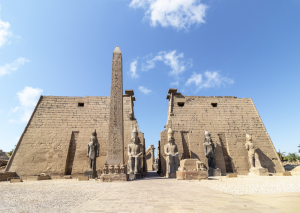Luxor temple was located in the heart of the ancient Thebes and like Karnak was dedicated to the god Amun or Amun-Re, and was built during the 18th Dynasty. The temple was called the Southern Opet or “Place of Seclusion” and its god Amun. 
The temple has been built on the site of even earlier structures, the history of the present structure embraces over 3000 years of growth.
The core area of Luxor Temple as it stands today was constructed by Amenophis III, the 18th dynasty’s great “Sun King”. He built it in two stages: in the first stage he constructed and decorated a multi-roomed complex and he added later to the north a sun court.
The temple was expanded again during the reign of Ramsis II, he constructed a huge pillared court and a pylon on a new axis, he built also a triple shrines which constructed to hold the barques of Amun, Mut & Khonsu.
The continuing importance of Luxor temple is also seen in the complete renewal of the central barque shrine in the name of Alexander the Great, after the Macedonian conquest of Egypt.
During the Byzantine period , many Christian churches were built in and around the temple of Luxor, in the 6th century one of these churches was built within the Ramessid court, and on top of this same building , in the 13th century , the Mosque of Abu Elhaggag was constructed.
Luxor Temple’s artwork includes some of the finest relief carving in Egypt and very well preserved because much of the temple was buried for centuries.
The present entrance is through the pylon of Ramsis II which is fronted by six colossi of the king, two seated & four standing, and two obelisks, but one of the obelisks was transported to Paris.
